The ruby throats, the only species of hummingbird that breeds in Eastern North America, always come back from Central America at the same moment as my bleeding hearts start blooming. No mystical or evolutionary correlation, just a colorful coincidence: two of nature’s most unusual creations having a moment together. They’re in the tall verbena (above) and elsewhere now.The bleeding heart, Dicentra spectabilis, is hardly the traditional trumpet-shaped flower hummingbirds are said to favor, nor is it red (reportedly their favorite color). It’s just one of the plants in my palette that has prov
Ornamental plants Ideas, Tips & Guides
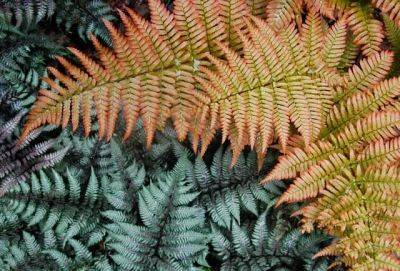
2 ferns with more lasting color than any flower
A NY FLOWER WOULD BE HARD-PRESSED TO COMPETE with the two most colorful ferns in the garden here, which have been showing off since the first crozier poked through the soil surface in early May and won’t stop till very late fall. No wonder I grow so many Japanese painted ferns and autumn ferns; they make shade gardening look easy, adding heavy doses of purple and silver or coral and gold, respectively, and never asking for so much as a deadheading in return.Japanese painted fern (Athyrium niponicum ‘Pictum’, Zones 5-8) is well-known to most gardeners the last decade, a showy thing with varying proportions and intensities of silvery-gray and purple coloration on its parts.
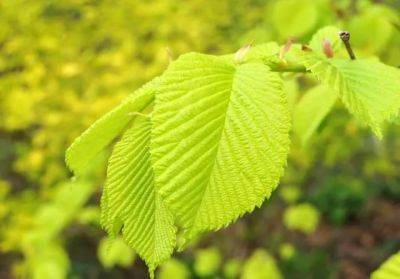
‘nature’s first green is gold’
WHEN I REMINDED THEM ABOUT MY SLIDESHOW OF SPRING in all its yellow shades, smart readers over on A Way to Garden’s Facebook page reminded me of Robert Frost’s gleaming line: “Nature’s first green is gold,” he wrote, in “Nothing Gold Can Stay.” See the slideshow of springtime’s favorite color, or click to read the poem first.Slideshow and Etc.Golden Days Spring Slideshow A Way to Garden on Facebook The leaf up top is a golden elm.

A closer look at tree bark, with michael wojtech
Michael Wojtech of Know Your Trees dot com and author of “Bark: A Field Guide to Trees of the Northeast” (Amazon affiliate link) can answer those questions, plus this one: Can you actually learn to identify trees by their bark (an especially useful skill now through spring, when many are leafless)? Hint: The answer is yes.Michael left a 15-year business career to pursue his love of natural history and writing, and earned his Master’s in Conservation Biology from Antioch University New England. His thesis, on tree bark, became the basis for the field guide. Though the book’s plant ID section covers trees of the Northeast, much of the ma
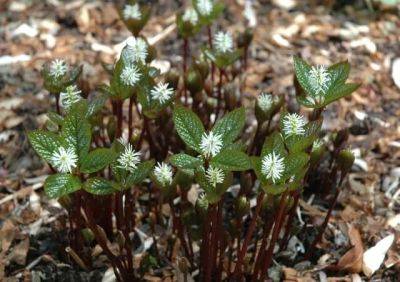
The growing family
MORE, MORE, MORE. Hard to keep up with things, with lilacs starting and crabapples coming into bloom and all of it.
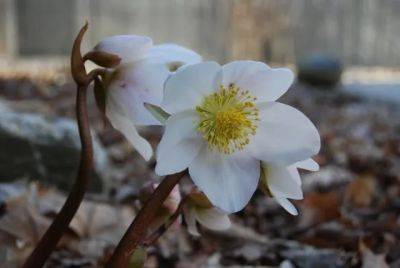
And the winner is…helleborus niger (again)
T HE FIRST RACE AT CUPCAKE DOWNS always has the same winner by a length: Helleborus niger, the Christmas rose, the first perennial to bloom, no matter what. This year is no exception (which is what “no matter what” means, perhaps you guessed) and here it is.
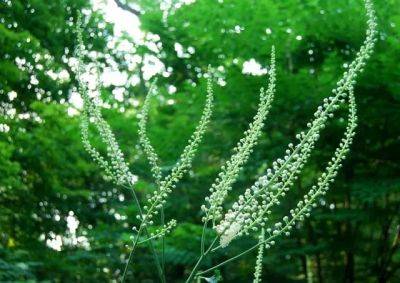
Scratch and sniff this cimicifuga post?
This native North American woodlander, also called black cohosh or bugbane or snakeroot, is slow to establish, and closely related to baneberry (Actaea rubra), which grows nearby it at my place like kissing cousins. My three black cohosh plants of a decade ago didn’t do much for years…and then they did. Now I have a glade of them, their astilbe-like foliage crowned with these sweet-smelling towering ivory wands throughout July here.When in flower, black cohosh (not to be confused with blue cohosh, a spring native) is 4 to 6 feet tall. Depending on the amount of light that filters through the canopy the spires are all wild (like the ones up top) or formally vertical (in a bit more sun, left). And as for needing maintenance: none.It will ask your patience, however, as I say. B
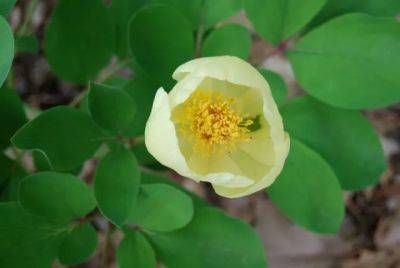
Blooming this week: species peonies
Just to be clear: I love herbaceous peonies, or P. lactiflora, the blowsy, fragrant lovelies of most late-spring gardens. But I don’t grow them in my mixed borders; I relegate them to a cutting area, where I have enough for many, many vases-full (but not even one-twentieth of the number Martha has!). I might have 25 plants, all of them from our old friends the Klehms in Illinois, and they’ll bloom in another couple of weeks. But what I am loving at the moment in the garden (not the vase) are peonies the way nature made them.Paeonia mlokosewitschii, more easily referred to as Molly the Witch, is a beautiful pale yellow, and enjoys a spot in a shady, woodland garden. My very big, old plant of nearly a decade ago, purchased at an auction at a bot
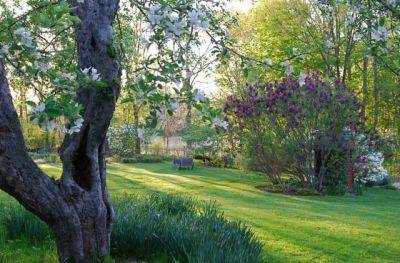
New lilac slideshow: call me old-fashioned!
THERE ARE MORE THAN 2,000 NAMED LILAC CULTIVARS, and I grow just a handful. But in early May, I feel as if I’m positively surrounded by them–one of the great joys of a Northern garden, where the climate suits these popular spring shrubs.
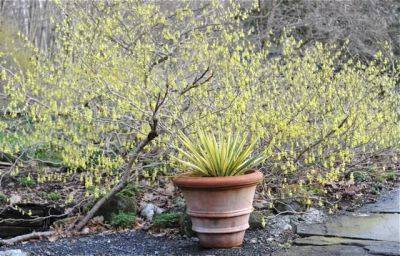
Blooming in my garden: april 25, 2011
AS IF THEY SIMPLY CANNOT WAIT ANY LONGER, the list of things starting to color up and open this cold, wet spring is accelerating–no matter whether the weather lifts its pall. From spike winterhazel (above) to the first of the Corydalis and Primula, here comes the start of full-on spring.
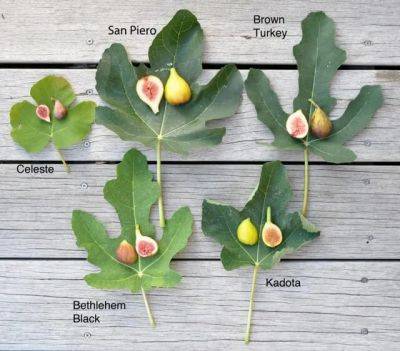
How to grow figs, with lee reich
I invited my favorite fruit expert, Lee Reich, author of many exceptional garden books, including “Grow Fruit Naturally” and “Weedless Gardening” and “The Pruning Book,” to come talk figs on my public-radio show and podcast. (I’m giving away a copy of “Grow Fruit Naturally;” enter by commenting in the box at the very bottom of the page.)I often refer to Lee as “the unusual fruit guy,” because one of his first books I read was “Uncommon Fruits Worthy of Attention.” Lee lives with blueberries and paw paws and medlars and kiwis and of course figs and more not far from me, across the Hudson in New Paltz, New York, on what he calls his farm-den (as in half-farm, half-garden) loaded with unusual fruits.Learn wh
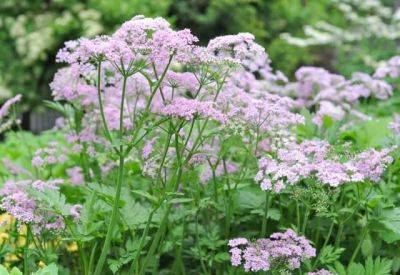
A plant i’d order: chaerophyllum hirsutum ‘roseum’
Truth be told, I cannot even usually recall its name at those moments, an embarrassing thing when you are hosting garden tours. Nor did I know that it had a “common” name, let along two (the other being pink cow parsnip, apparently).I’d never gotten up close and personal enough with this lovely plant all these years to notice if it’s really apple-scented the way the references all say it is. (I just went out and took a whiff, and I say no. Smells to this nose like parsley, or something else green; no apples here.)What this little umbellifer of about 2 feet tall in bloom does have is good ferny foliage (not unlike its namesake chervil
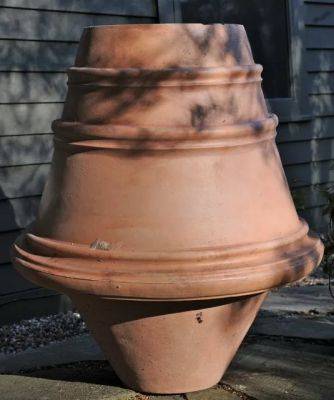
More frost and freezes: minimizing damage
In March, I outlined tactics–such as making sure things are well-watered before a dip in temperatures–and offered links to detailed frost-minimizing strategies in this story that would be a helpful read if you’re gardening in a blue zone as I am on the current National Weather Service map.This weekend, I pulled out all the stops (and empty pots, tomato cages, bed linens, garden carts, you name it…) like in the slideshow below, and got help to wheel my big potted Japanese maples–whose leaves are very sensitive to frost–back into the barn, where I overwinter them, but had set them free a week ago. Oops.(Click on the first thumbnail to start the slideshow, then toggle from side to slide with the arrow keys on your computer, or using the arrows next to each caption.)Always be sure to remove covers before the sun hits the plants the next day, even if another night of frost or freeze is forecast. Which means out I go before supper to re-cover everything and hope aga

Great shrub: physocarpus opulifolius
Long before I grew ‘Diablo’ (the name on its tag, but which I later learned is ‘Diabolo’) I brought a rooted cutting of the golden-leaf form of Physocarpus (above), called ‘Dart’s Gold,’ home from Western Hills Nursery in Northern California. Or at least I thought it was ‘Dart’s Gold.’But like ‘Diablo,’ my so-called ‘Dart’s Gold’ got really big in time, like 10 by 10 feet or even wider; the labels say otherwise, that it gets to just 5 feet or so. I suspect my gold one is just ‘Luteus,’ or maybe ‘Luteus’ and ‘Dart’s Gold’ are the same thing, who knows?
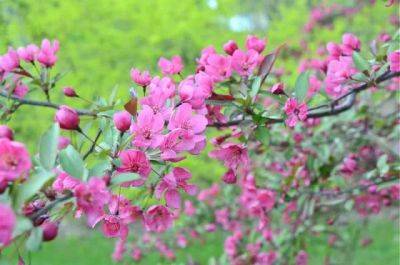
That crabapple moment 2011
ONE OF MY TOP BIRD-GARDEN PICKS (and not bad from a gardener’s-eye view, either) has been stealing the show the last few days. It’s crabapple season here, so I wanted to be sure to invite you to stroll through my slideshow on them, which includes lots of tips and links loaded with crabapple information as well.

Punctuating the garden: columnar evergreens
This first-ever columnar conifer in my garden career came about quite by accident. I was actually looking for what a friend refers to as “a blob” (a sort of lumpy, wider-than-tall, hummocky-shaped shrub) to replace a Daphne ‘Carol Mackie’ that was badly snow-damaged last fall.Shop as I might for the right new “blob,” I saw nothing that was just right. And then I bumped into another friend at the garden center, who said, “Why not something vertical instead? Change it up.” Aha!punctuation points i considered:<a href=«http://www.missouribotanicalgarden.org/gardens-gardening/your-garden/plant-finder/plant-details/kc/f930/thuja-occidentalis-degroot» s-spire.aspx>Thuja occidentalis ‘Degroot’s Spire:’ Ilex crenata ‘Sky Pencil’ (Japanese holly): Grows to 10 feet and 2-3 feet wide; will need help, such as from a cat’s cradle of fishing lin
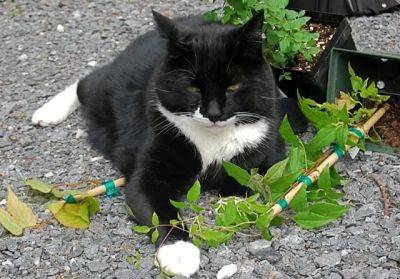
High on vines: intoxicating garden climbers
J ACK IS A JUNKIE; KIWI VINES ARE HIS CRACK. He knocked down that little Clematis to his left in the process of capturing and subduing his desired prey: the young kiwi vine that’s now half-hidden beneath the subdued cat (above). Yes, some species of kiwi are like catnip, and though Jack thinks that’s the reason to add more to the garden, I’m high on other vines that are coming into their season, from vivid Clematis tangutica to (not yet, but soon) Codonopsis lanceolata.
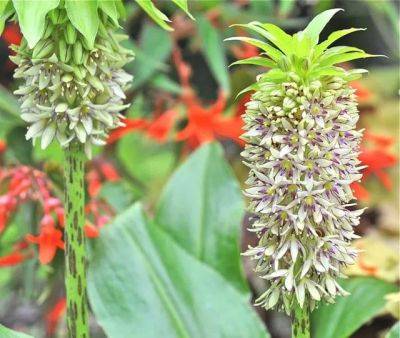
Pineapple-lily season: easy eucomis bicolor
NEXT TO CANNAS, which are about the easiest non-hardy bulbs or bulb-like plants to carry over year to year carefree in the cellar, I’d have to say that Eucomis bicolor, the pineapple lily (Zones 7 or 8 to 10), is winning me over for its similarly cooperative nature and long season of showing off. I enjoyed the potful that a friend gave me so much that this spring I ordered a dozen bulbs, and put three or four in each of several 12-inch containers.

The best euphorbia?
E. palustris, as its species name reveals, is a marsh-type plant, so wet and heavy soils are no problem for it (though it doesn’t seem to require them). Most spurges are finicky about such conditions. Not this one. It gets to between 2 and 3 feet tall and at least as wide.I grow seven or eight other Euphorbias, including the basic polychroma, its newer, red-foliage variant called ‘Bonfire,’ and the fiery-colored one called E. griffithii ‘Dixter’ [above]. In California, mail-order Digging Dog Nursery has a good list of spurges, but not palustris. I swore I got my most recent generation of plants at Forestfarm, but I don’t see it in their current list. Hmmm….how about Annie’s Annuals?The hardest thing about growing spurges is cutting them back,
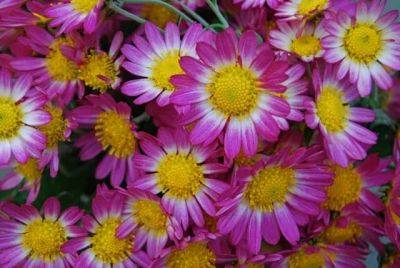
If you only have one mum…
I found ‘Will’ (along with many other good things over the years) at the now-closed Seneca Hill Perennials. Former owner Ellen Hornig dubbed the plant ‘Will’s Wonderful’ because it was given to her by someone named Will, not because either of them knows its actual name. (Update September 2011: As of fall 2009, Ellen was no longer selling it, so for awhile I suggested to readers that another pink, maybe ‘Cambodian Queen,’ from the selection at Lazy S’s might be one to consider. ‘Sheffield Pink,’ which they also have, is lovely, too, but not bawdy at all. In 2010, Lazy S’s added ‘Will’ to its collection–meaning ‘Will’ found a new retail home. Update 2019: Though Lazy S’s went out of business, Avant Gardens also started selling Will.)What Ellen and I and Lazy S’s and Kathy Tracey of Avant Gardens all like about ‘Will’ is that he shows up extra-late, just when you have given up on anything daring to flower, and also the indescribable way he colors up and then fades: a sequence of shocking hues, one nicer than the next. Like I said, I can’t describe it, exactly, but it starts with red buds, opens to wha
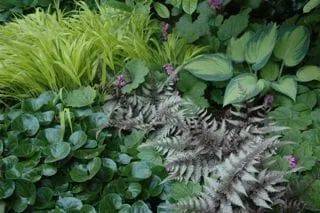
Touchy-feely plants
SOMETIME AGO, I overheard visitors to one of the country’s finest public gardens recounting their experience. “I liked it,” said one woman, who called herself a professional gardener, “but I didn’t like that all the plants touched.” I think perhaps she missed the point: That’s the best part, the making of botanical mosaics, the weaving-together of things; the part when the mulch disappears.

Weeping kousa: does it stay, or go?
I have a number of Kousa dogwoods, or Cornus kousa, a species native to Japan, China and Korea that’s been in cultivation since Victorian times. I’m sure you know it; besides later, larger flowers than our native C. florida, it has larger fruit and good fall color (so does the American). The Kousa’s bark gets handsome as it matures, peeling in the nicest camouflage pattern, and the tree seems virtually disease-resistant, especially compared to the American with its susceptiblity to anthracnose fungus. But I digress from the beauty-contest at hand.Here’s the thing: I’ve never liked the plant, named C.k. ‘Lustgarten Weeping,’ which I’ve grown from a tiny grafted creature of mere twig-like proportion I bought from Dan Hinkley maybe a decade ago, to its current 9-foot spread and 5-foot height. Every year I mean to toss it out. Really.
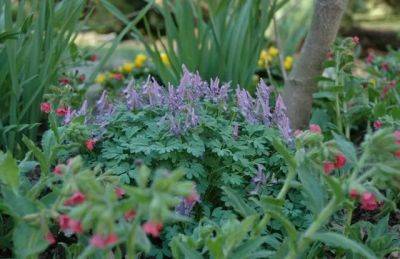
My vanishing corydalis solida: simple division?
I’m casting my vote for chipmunks, who seem intent on redesigning the garden, morsel by morsel. They especially like to move things like small bulbs (crocus, for instance, which I now have in one-sies in the oddest and most remote places) or little tubers like those of Corydalis solida (ditto). The photo shows it where it bloomed last year withPulmonaria rubra (red) and Hylomecon japonicum (the yellow blurs at the back).This rock-garden treasure jumps up out of the ground, blooms, and disappears in a month or so each spring, and never gave me any trouble in semi-shaded spots (by which in this case I mean sunny in early spring but somewhat shaded in the hot months). Besides the lavender one I grow (grew?) there’s also a blush-colored version appropriately called ‘Blushing Girl’ available through Seneca Hill, and a pink one named ‘Beth Evans’ at White Flower Farm, and I have read about but
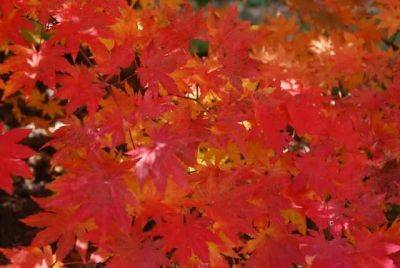
Fall’s finest: savoring some last bits
IT HAS BEEN MONTHS SINCE I uploaded a photo gallery, and right now it’s definitely carpe diem…or carpe not at all, with the last bits fading fast. Here, then, are some of the final stars, the stalwarts of recent weeks, who despite harsh times gave (and give) mightily.
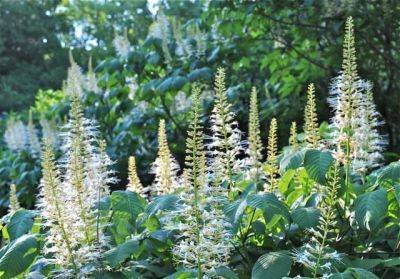
Fireworks! the bottlebrush buckeye celebrates
AS IF IT KNOWS THAT FIREWORKS ARE CALLED FOR this weekend, the biggest old bottlebrush buckeye here, Aesculus parviflora (above), is in full bloom. Pow! A 15-foot-wide by 12-foot-tall mass of high energy, with each bloom more than a foot tall.

Begonia of the week: ‘dragon wing’ red
When it first came into mass production less than 10 years ago, I was working at Martha Stewart Living, and the folks at Ball Horticultural who were touting the plant to wholesalers and the press send me some babies to try. Baby they did not remain for very long, since ‘Dragon Wing’ is a lusty creature: One plant will easily fill a 10-inch pot all by itself, and gets to about 2 feet tall. It grows in semi-shade or even pretty substantial sun in my experience, and wants regular watering (but never to be sodden) and a dose of fish-emulsion and seaweed solution pretty regularly. A hungry thing.‘Dragon Wing,’ which also comes in a pink-flowered form, blooms and blooms all season, with pendulous trusses of hot-red blossoms. When it came on the market, cooperative extension agents from many of the Southern states raved about it for its heat tolera
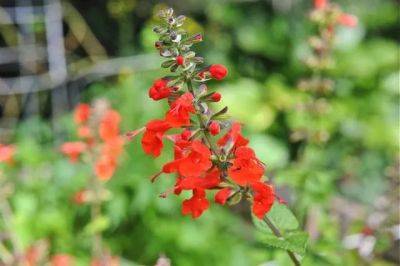
3 favorite salvias, all of them (screaming) red
THE LAST OF THE FEMALE HUMMINGBIRDS have just departed for points south, following the males who left well ahead of time as if to set up camp. But onward bloom three of my favorite hummingbird plants, three red-flowered salvias I always include in the garden somewhere, year to year.
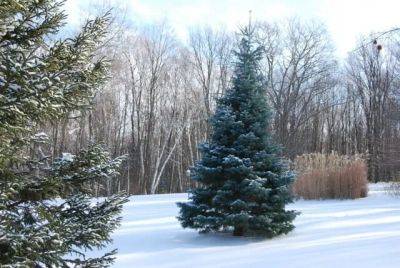
Beloved conifer: the concolor fir
I have two other Abies concolor here (I know, there’s evidence of my former“everything in threes” insanity again), the other two grown naturally, unshorn, and therefore quite different-looking. I won’t tell you what I paid for the big guy, all thick and a perfect pyramid and already near 10 feet tall when he came to me to live on my hillside of a backyard, among the crabapples and a giant island of ornamental grasses. The others were scrawny little things, maybe 3 feet high, though each is more than 15 tall now.The white, or concolor fir, a Western American native species ranging from Colorado to Southern California, New Mexico and into Mexico, can grow to 100 feet in the wild, apparently, but in a garden setting you are more likely to see it get to 30 or maybe 50 feet in time, and half as wide.Its long needles, which are particularly silvery-blue in the cultivar ‘Candicans,’ curve outward

And you’re waking up NOW?
Recalcitrant, to the max, apparently. Just plain uncooperative, and following a beat of their own.Seven months after they arrived, on nearly the shortest day of the year with months of low light and cold ahead, they have risen.Oh, perfect. Of course I have any number of ideal conditions to offer these late-sleeper: Will it be a radiator, my sleepyhead darlings, or a drafty windowsill? (Kidding. Both are certain death.)The description on my friend Tony Avent’s Plant Delight Nursery web

A less-common autumn clematis, c. tangutica
That’s not to say that C. tangutica cultivars aren’t beasts of a vine, too. As with C. terniflora, I cut these back hard in early spring, to less than a foot above the ground. They nevertheless produces a rampant amount of growth, to more than 10 feet tall, and around mid- to late August start to open up an increasing number of charming yellow bells: lemons with their peels unfurled in quarters. (If I didn’t hack it in spring, but simply clean out the dead stuff a little, it starts blooming for me in June.)I know I’m being imprecise, but frankly I cannot tell several of the good tangutica cultivars apart. I think mine’s‘Gravetye Variety,’ with deepest maroon anthers, and other good cultivars to look for include ‘Bill MacKenzie’ and ‘Golden Harvest.’ My tangutica type doesn’t cover itself in the sweet-scented froth of flowers of C. terniflora, a Japanese native that’s got a reputation as a terrible thug, or like its native American, far b

Pansies i have loved
Rule No. 1: I like pansies and violas best when they are used in low bowls like the ones pictured here, and I have made a practice of buying terra cotta bowls large and small over the years to accommodate this propensity.Rule No. 2: I like one variety of pansy or viola per bowl, thank you.Rule No. 3: I will happily make an occasional exception to Rule No. 2 if we are talking about combining two solid-color pansies or two solid-color violas that look good together. (I am in charge of all the rules, including what I deem looks good together; see Rule No. 4.)Rule

Giveaway: vines q&a with brushwood’s dan long
Brushwood Nursery, aka gardenvines [dot] com, was founded in 1998 in Kennett Square, Pennsylvania, out of a Lord and Burnham greenhouse Dan rented for $5 a year plus upkeep. (Such a deal!) Dan, a University of Delaware horticulture graduate, used to teach at nearby Longwood Gardens and worked with Conard-Pyle, where he got fluent in the propagation of Clematis, which most nurseries call “a nuisance crop,” he says, with their particular trimming schedules and rambunctious intertwining tendencies.Enter a business opportunity: a high dollar-per-square-foot greenhouse crop, and one that not everyone is good at–enter Brushwood. He started selling vines over eBay, eventually launching his own website, and recently outgrew the climate and space in Pennsylvania and moved to Athens, Georgia.The Brushwood collection now numbers more than 500 climbers, with Clematis as the main event—including ‘Omoshiro,’ top photo, which may be the first large-flowered one I ever buy (it’s more than 7 inches across, and fragrant). There are climbing roses, jasmines, passionflowers and more–but let Dan tell
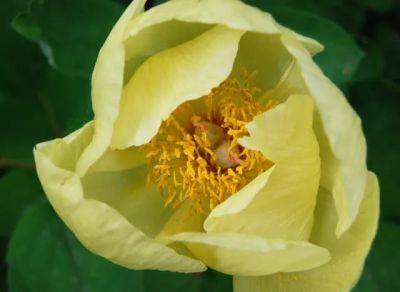
Fall planting: 21 powerhouse perennials i’d order
LESPEDEZA THUNBERGII: A 6-by-6 fountain of late-summer into fall purple glory. Easy, too.HAKONECHLOA ‘ALL GOLD’: The Japanese forest grass turns my shady garden areas golden tones from May into winter.HELLEBORE HYBRIDS: Dry shade? No problem. Forgiving, beautiful, extra-early blooming perennials with evergreen foliage to boot.SEDUM ‘MATRONA’: Maybe my favorite of the taller sedums, all blue-green and pinkish in that sedum-y way.GERANIUM PHAEUM ‘SAMOBOR’: Perennial geraniums are a must; this one’s perhaps the mustest, showy and cooperative.LATHYRUS VERNUS: A little perennial pea of early spring (above) that’s delicate and durable; one of my sprin
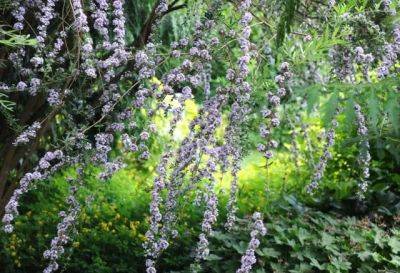
Great shrub: the ‘other’ butterfly bush
It’s fast growing.Its foliage is willow-like, and in the ‘Argentea’ (meaning silver-leaved) cultivar I grow, a pleasing grayish-green, if not wildly silver.Its flowers are fragrant, like those of its cousins. Deadheading after bloom will somewhat reduce the messy twiginess, especially of older plants.And like I said, the butterflies really like it.Sources for Buddleia alternifolia: At High Country Gardens At Forest Farm Categoriesdeciduous trees & shrubsTagsbutterfly plants
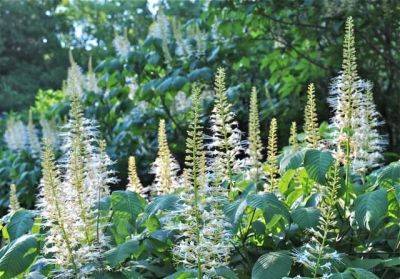
Fallen hero: bottlebrush buckeye
The bottlebrush buckeye, one of four around the yard, had grown to a hummock-shaped thing of about 10 feet high and 15 or so feet across, a community unto itself with many suckers beneath the oldest stems. This suckering habit will prove to be its (and my) salvation, as younger shoots are known to grow several feet a year, which gives me hope that in time I’ll have my hummock back.I waded into the fallen mess carefully just yesterday, once I’d had time to really look at it for a few days from all angles and think about the right approach to its rejuvenation. (Up top is how the damaged shrub looked from the house; just above, from farther out in the landscape, looking toward

A plant i’d order: lathyrus vernus
Lathyrus vernus plays well with others, and doesn’t ask for any attention. It even tolerates rather dry spots in the woodland garden, hallelujah, though I grow it in sunnier areas, too. Sold?In my garden, Lathyrus vernus coincides with the mid-season to late Narcissus, and is in full color with the acid-yellow early euphorbias, hellebores and pulmonarias, among other
Popular Topics
Our site greengrove.cc offers you to spend great time reading Ornamental plants latest Tips & Guides. Enjoy scrolling Ornamental plants Tips & Guides to learn more. Stay tuned following daily updates of Ornamental plants hacks and apply them in your real life. Be sure, you won’t regret entering the site once, because here you will find a lot of useful Ornamental plants stuff that will help you a lot in your daily life! Check it out yourself!
